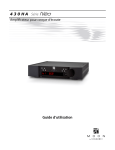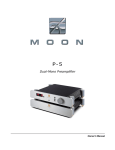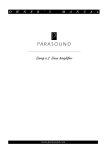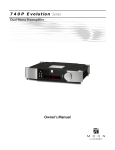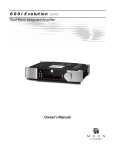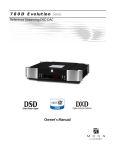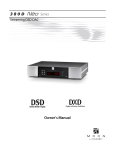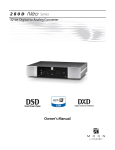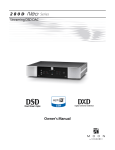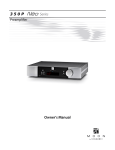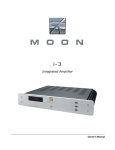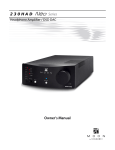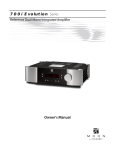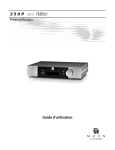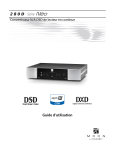Download Neo 430HA Headphone Amplifier
Transcript
430HA Series Headphone Amplifier Owner’s Manual 430HA Nēo Series Owner’s Manual Important Safety Instructions 1. Read these instructions. 2. Keep these instructions. 3. Heed all warnings. 4. Follow all instructions. 5. Do not use this apparatus near water. 6. Clean only with a dry cloth. 7. Do not block ventilation openings. Install in accordance with the manufacturer’s instructions. 8. Do not install near any heat sources such as radiators, heat registers, stoves or another apparatus that produces heat. 9. Do not defeat the safety purpose of the polarized or grounding type plug. A polarized plug has two blades with one wider than the other. A groundingtype plug has two blades and a third grounding prong. The wide blade or the third prong is provided for safety. If the provided plug does not fit into the outlet, consult an electrician for replacement of the obsolete outlet. 10. Protect the power cord from being walked on or pinched, particularly at plugs, convenience receptacles, and the point where they exit from the apparatus. Unplug mains cord during transportation. 11. Only use attachments and accessories specified by the manufacturer. 12. Use only with the cart, stand, tripod, bracket, or table specified by the manufacturer or sold with the apparatus. When a cart is used, use caution when moving the cart/apparatus combination to avoid injury from tip over. 13. Unplug this apparatus during lightning storms or when unused for long periods of time. 14. Refer all servicing to qualified service personnel. Servicing is required when the apparatus has been damaged in any way, such as when the power cord or plug has been damaged; liquid has been spilled or objects have fallen into the apparatus; or the apparatus has been exposed to rain or moisture, does not operate normally, or has been dropped. 15. No naked flame sources, such as candles, should be placed on the apparatus. WARNING: TO REDUCE THE RISK OF FIRE OR ELECTRIC SHOCK, DO NOT EXPOSE THIS APPLIANCE TO RAIN OR MOISTURE. 430HA Nēo Series Important Safety Instructions (cont’d) The lightning flash with the arrowhead symbol, within an equilateral triangle, is intended to alert the user to the presence of uninsulated “dangerous voltage” within the product’s enclosure that may be of sufficient magnitude to constitute a risk of electric shock to persons. The exclamation point within an equilateral triangle is intended to alert the user to the presence of important operating and maintenance (servicing) instructions in the literature accompanying the appliance. Marking by the “CE” symbol (shown left) indicates compliance of this device with the EMC (Electromagnetic Compatibility) and LVD (Low Voltage Directive) standards of the European Community Please read all instructions and precautions carefully and completely before operating your Nēo 430HA Headphone Amplifier. 1. ALWAYS disconnect your entire system from the AC mains before connecting or disconnecting any cables, or when cleaning any component. To completely disconnect this apparatus from the AC mains, disconnect the power supply cord plug from the AC receptacle. 2. The Nēo 430HA must be terminated with a three-conductor AC mains power cord which includes an earth ground connection. To prevent shock hazard, all three connections must ALWAYS be used. Connect the Nēo 430HA only to an AC source of the proper voltage; Both the shipping box and rear panel serial number label will indicate the correct voltage. Use of any other voltage will likely damage the unit and void the warranty 6. NEVER wet the inside of the Nēo 430HA with any liquid. If a liquid substance does enter your Nēo 430HA, immediately disconnect it from the AC mains and take it to your MOON dealer for a complete check-up. 7. NEVER spill or pour liquids directly onto the Nēo 430HA. 8. NEVER block air flow through ventilation slots or heatsinks. 9. NEVER bypass any fuse. 10. NEVER replace any fuse with a value or type other than those specified 11. NEVER attempt to repair the Nēo 430HA. If a problem occurs contact your MOON dealer. AC extension cords are NOT recommended for use with this product. The mains plug of the power supply cord shall remain readily accessible. 12. NEVER expose the Nēo 430HA to extremely high or low temperatures. 4. NEVER use flammable or combustible chemicals for cleaning audio components. 14. ALWAYS keep electrical equipment out of reach of children. 5. NEVER operate the Nēo 430HA with any covers removed. There are no user-serviceable parts inside. An open unit, especially if it is still connected to an AC source, presents a potentially lethal shock hazard. Refer all questions to authorized service personnel only. 15. ALWAYS unplug sensitive electronic equipment during lightning storms. 3. 13. NEVER operate the Nēo 430HA in an explosive atmosphere. 16. WARNING: Do not expose batteries or battery pack to excessive heat such as sunshine, or fire or the like. Owner’s Manual Table of Contents Introduction Unpacking Installation & Placement Front Panel Controls Optional Digital Inputs Rear Panel Connections Balanced Operation SimLink™ Operating the Nēo 430HA Remote Control Operation Specifications 6 7 7 8 10 10 11 11 12 13 15 www.simaudio.com Simaudio Ltd., 1345 Newton Road Boucherville, Québec J4B 5H2 CANADA Date Code: 20150805 430HA Nēo Series Introduction Thank you for selecting the Nēo 430HA Headphone Amplifier as a part of your hi-fi reproduction system. This Headphone Amplifier has been designed to offer state-of-the-art high-end performance in an elegant package, while retaining all the sonic hallmarks on which Simaudio has made its reputation. We have spared no effort to ensure that it is among the finest headphone amplifiers available. We have been building high-performance audio equipment for over 30 years, and the know-how gained through our cumulative experience is an important reason why MOON Headphone Amplifiers are so musically satisfying. Balanced Outputs hidden behind sliding front panel window (2x 3-pin XLR, 1x 4-pin XLR), as well as a 1/4" TRS jack, and both fixed & variable line-level single-ended RCA stereo pairs The performance of your 430HA will continue to improve during the first 300 hours of listening. This is the result of a “break-in” period required for the numerous high quality electronic parts used throughout this headphone amplifier. M-eVOL2 volume control circuit using MDAC's (operating in a current steering R-2R configuration) which alter the audio signal's amplitude, yielding no sonic degradation of the signal, regardless of the selected volume setting. This circuit offers 530 steps and channel matching of 0.1dB Before setting up your new Nēo 430HA, we encourage you to please read this manual thoroughly to properly acquaint yourself with its features. We hope you enjoy listening to the Nēo 430HA Headhone Amplifier as much as the pride we have taken in creating this fine audio product. We understand the power and emotion of music and build our products with the goal of faithfully capturing these elusive qualities. The information contained in this manual is subject to change without notice. The most current version of this manual is available on our official website at http://www.simaudio.com An oversized power supply using 2 toroidal transformers in conjunction with 8 stages of DC voltage regulation 4 stages of our M-LoVo (MOON Low Voltage) DC regulation circuit; a highly sophisticated circuit that is virtually free of noise, yielding an exceptionally fast, precise, and stable DC voltage. This circuit, found in the Evolution series 810LP Phono Preamplifier and 740P Preamplifier, results in a power supply with a virtually unmeasureable noise floor Optional Digital-to-Analog Converter (DAC) with four (4) digital inputs (S/PDIF x 2, TosLink x 1 & USB x 1) allowing for use with virtually any digital source; Supports DSD64, DSD128 and DSD256 (USB input only); Supports PCM 16/44.4kHz to 24/192kHz (all inputs) and up to PCM 32/384kHz (USB input only) EuP compatible eco-friendly power (less than 0.5W) in standby mode with defeatable 20 minutes inactivity "auto shut off" 12 Volt trigger output for remote operations RS-232 port for (i) full unsolicited bidirectional feedback and (ii) firmware updates IR input for external control Your Nēo 430HA Headphone Amplifier incorporates many significant design features to achieve its “worldclass” level of performance. This is an abbreviated list of the more important features: Fully balanced, pure analog amplifier includes a discrete transconductance circuit topology Selectable gain setting (14d or 20dB) Defeatable analog Crossfeed 'spacialization' and listening comfort 6 SimLink™ controller port for 2-way communications with other compatible MOON components Rigid chassis construction to minimize the effects of external vibrations Optimized selection of very high quality electronic components Low operating expectancy.. circuit for better temperature for an ultra-long life Owner’s Manual Unpacking The Nēo 430HA headphone amplifier should be removed from its box with care. The following accessories should be included inside the box with your headphone amplifier: 9 9 9 9 9 AC power cable ‘CRM-2’ remote control with two ‘AA’ batteries ‘SimLink™’ cable with 1/8” mini plug terminations on each end This owner’s manual Warranty and product registration information (USA and Canada only) Once the Nēo 430HA is unpacked, inspect it thoroughly and report any damage to your dealer immediately. We suggest that you keep all of the original packaging, storing it in a safe, dry place in case you’re required to transport this product. The customized packaging is specially designed to protect the 430HA from any potential damage during transit. Please write the serial number of your new Nēo 430HA in the space provided below for future reference. Serial Number Installation & Placement The Nēo 430HA requires only minimal ventilation to maintain an optimum and consistent operating temperature. However, you should avoid placing it near a heat source as this could compromise the headphone amplifier’s performance and reliability. As well, it should be placed on a solid level surface. The 430HA uses toroidal transformers; even though they are well shielded, you should not place the preamplifier too close to source components sensitive to EMI, such as a turntables.. If your Nēo 430HA is equipped with the DAC option and you intend to use the USB input connection (PCM or DSD) with a Windows-based computer, you will need to install our USB HD DSD driver, which can be downloaded from the support section of our website. .Note: Apple-based computers don’t require this driver. Note: We recommend connecting only one pair of headphones at a time to the Nēo 430HA. 7 430HA Nēo Series Front Panel Controls Figure 1: Nēo 430HA Front panel The front panel will look similar to Figure 1 (above). The large display window indicates the selected input and volume level setting. If your Nēo 430HA includes the Digital-to-Analog converter (DAC) option, the digital input signal’s sampling rate will briefly appear in the display window. Refer to the section entitled “Optional Digital Inputs” on page 10 for further details. The “Standby” button disengages all internal circuitry from the power supply, except for the controller circuit and the IR receiver. The blue indicator LED turns off when the Nēo 430HA is in “Standby” mode. When switching back from “Standby” to the “on” mode, the blue LED directly above the display window will illuminate and the current ‘input’ will be memorized from the previous listening session. When you press and hold the “Standby” button for approximately 3 seconds, all components connected to the 430HA via SimLink™ will also switch between “Standby” mode and “on” mode. Please refer to the section entitled SimLink™ for further details.The 430HA will automatically go into standby mode after approximately 20 minutes of inactivity. To disable this feature, please refer to the “Mute” button details on the following page. The “Gain” button allows you to switch between a low gain (14db) setting and a high gain (20dB) setting. The default setting is low gain. When you engage this button, the corresponding setting wil appear briefly in the display window as either “Lo” or “Hi”. The high gain setting should be used in situations when (i) your source component connected to the 430HA has a low output signal (ii) your headphones have either a low sensitivity or low efficiency rating. When you press and hold the “Gain” button for approximately 3 seconds, the current version of installed firmware will appear briefly in the display window. 8 When your Nēo 430HA is equipped with the optional DAC, pressing the "Display" button allows you to alternate the contents of the display window’s right side between the volume level and the sampling rate of the digital input signal for the four (4) digital inputs (D1, D2, D3 and D4). Note: When the volume level is displayed and the digital input signal’s sampling rate changes, the new sampling rate will appear briefly. The volume level will always be displayed on the right side for the three (3) analog inputs (A1, A2, B1). The “Display” button also allows you to turn the digital display on and off. If you want to turn the display off, press and hold the “Display” button for 3 seconds. When the display is turned off, it will still illuminate for a short period of time whenever you press any of the buttons located on the front panel or the remote control; the display will automatically turn off again once you are done. To turn the display back on, simply press and hold the “Display” button for 3 seconds. The “Xfeed” button engages the Nēo 430HA’s internal Crossfeed circuit. When activated the red LED, located to the right of this button, will illuminate. The Crossfeed circuit is designed to reduce listener fatigue that may result from stereo recordings with extreme channel separation. This feat is accomplished by (i) blending a small amount of the music from the left channel into the right channel and (ii) blending a small amount of the music from the right channel into the left channel. Owner’s Manual The two (2) buttons labeled ◄ INPUT ► allow you to sequentially scroll, either forward (►) or backward (◄) through all of the available inputs. Depending on whether or not the DAC option is installed, the order of the inputs is as follows going forward (►): Basic Unit: “A1”, “A2” and “B1”; DAC option installed: “A1”, “A2”, “B1”, “D1”, “D2”, “D3” and “D4” The above abbreviations correspond to the labeling of the rear panel inputs. “A1”, “A2” and “B1” are intended for use with any type of source component that outputs an analog signal: “A1” and “A2” for single-ended sources using RCA connectors; “B1” for balanced sources using XLR connectors. If you have installed the DAC option, “D1”, “D2”, “D3” and “D4” will appear after “B1”. The “Mute” button mutes the output signal to the headphone outputs, as well as both the fixed and variable line output connectors (refer to the section entitled “Rear Panel Connections” for further details). As well, the volume level setting will no longer appear in the display widow. Pressing the “Mute” button a second time will reinstate the volume back to its previous level. When the output signal is muted, the red LED to the right will repeatedly flash on and off. Note: Adjusting the volume level while the “Mute” function is active will immediately de-activate the “Mute” function. The Nēo 430HA is Energy Using Product (EuP) compatible. This is a European standard that effectively limits the off and standby power consumption to no more than 0.5W. When the EuP function is active, the unit will automatically turn off after 20 minutes of inactivity. The “Mute” button allows you to activate and de-activate the EuP function as follows; press and hold the “Mute” button for approximately 3 seconds to toggle EuP on (default setting) or off. The display will show "EuP" or "No EuP", respectively, whenver the EuP setting changes. The EuP setting is maintained when the 430HA is both powered down and placed into “Standby” mode. The “MP” button (for Media Player) has its input connection located above the headphone jack for easy access. It uses a 1/8” mini-jack connector which is the most common type of connection found on portable media players. When selected, the corresponding red LED, located to the right of the button, will illuminate. When the “MP” input is in use the display window automatically turns off. The “Display” button allows you to turn the digital display on and off. The rotary “volume” control determines the volume level, which ranges from ‘0.0dB’ (no output) to ’80.0dB’ (full output). This control does not function like a typical volume: When you rotate the dial, either clockwise to raise the volume or counter-clockwise to lower the volume, you are actually engaging a precision optical encoder which selects very high quality metal-film resistors that the audio signal passes through. The result is a proprietary volume circuit, called M-eVOL2 that doesn’t degrade the audio signal regardless of the setting, unlike all potentiometer based circuits. Since this circuitry operates in a fully balanced differential mode, no noise is introduced to the audio signal. The Nēo 430HA Headphone Amplifier provides a range of five-hundred and thirty (530) unique volume settings. This is achieved as follows: Within the 0.0dB to 30.0dB range, you can increase and decrease the volume in 1.0dB steps. From the 30.0dB to 80.0dB range, you can increase and decrease the volume by either 0.1dB or 1.0dB steps; By rotating the volume control slowly, the level will change by 0.1dB increments. A quicker rotation will change the volume in 1.0dB increments. Note: It is normal to hear a faint clicking sound between each step when adjusting the volume. This is the result of the volume circuit being optimized for sound quality. There are three (3) different headphone outputs located on the front panel of the Nēo 430HA. The first is the “Phones” jack, located directly below the “MP in” jack. This is used for connecting a pair of single-ended stereo headphones to the 430HA. The input connector uses a standard single-ended ¼” TRS jack. The two other headphone outputs are hidden behind the right side of the display window. To expose them, simply slide the display window to the left. This is done by placing one of your fingers into the contoured groove, located on the far right side of the window, and gently sliding it to the left until it stops moving; when the groove is vertically aligned to the blue indicator LED. You will now see three (3) female XLR connectors; The left and middle sockets are 3-pin XLR connectors, intended for use with a pair of dual-mono fully balanced headphones equipped with two 3-pin XLR male connectors. The right socket is a 4-pin XLR connector, intended for use with a pair of fully balanced headphones equipped with one 4-pin male connector. When none of these three XLR connectors are in use, you should close the display window; this is done by placing one of your fingers onto the left side contoured groove and gently sliding it to the right until it stops moving. 9 430HA Nēo Series Optional Digital Inputs T The Digital Input option includes four (4) separate inputs: “D1” uses an optical Toslink connector, “D2” and “D3” use S/PDIF on an female RCA connector and “D4” uses a type-B USB connector. The “D1” is intended for use with a source equipped with a TosLink digital output such as a satellite dish receiver or DVD player; The “D2” and “D3” inputs are intended for use with a source equipped with a S/PDIF digital output such as a network player, music server or CD transport. The “D4” input is for use with a computer equipped with a USB connector and music player software; you cannot connect a USB flash drive or external hard drive to the “D4” input. When you select one of the digital inputs the display window will indicate which of the four digital inputs is selected. At the same time, the right side of the display window will initially show four dashes as follows “----” which indicates that the Nēo 430HA is in the process of locking onto the external digital input signal – this may take several seconds. Once the 430HA successfully locks onto the digital signal, the four dashes will be replaced by the sampling rate of this digital signal. When the DAC cannot lock onto signal, “----” remains in the display window. The optional DAC is capable of processing the following data/sampling frequency rates. The corresponding values as they appear in the display window are listed directly below each rate:. PCM: 32.0kHz, 44.1kHz, 48.0kHz, 88.2kHz, 96kHz, 176.4kHz, 192kHz, 352.8 and 384kHz Displays as: 32.0 DSD: DSD64 (2.82MHz), DSD128 (5.64MHz) and DSD256 (11.28MHz) Displays as: DSd 44.1 48.0 DSd.2 88.2 96.0 176.0 192.0 352.8 and 384.0 and DSd.4 Notes: (i) DSD format signals can ONLY be played through the USB (“D4”) input. (ii) PCM format signals with sample-rates of 352.8kHz and 384kHz can ONLY be played through the USB (“D4”) input. Rear Panel Connections Figure 2: Nēo 430HA Rear panel The rear panel will look similar to Figure 2 (above). There are two (2) pairs of single-ended analog inputs on RCA connectors labeled “A1” and “A2” followed by one (1) pair of balanced analog inputs on XLR connectors labeled “B1”. The RCA input and output connectors on the rear panel have been color coded: ‘white’ for the left channel and ‘red’ for the right channel. 10 Owner’s Manual The Nēo 430HA headphone amplifier has two (2) pairs of single-ended outputs on RCA connectors, labeled ‘FIX’ and ‘VAR’, located next to the “B1” balanced input. The ‘FIX’ output is intended as an input to a recording device such as a cassette tape deck or CD-Recorder Player. Keep in mind that the output level is fixed and cannot be adjusted by the 430HA’s volume control. The ‘VAR’ output is designated for output to a power amplifier with single-ended RCA inputs. Don’t hesitate to use high quality interconnect cables*. Poor quality interconnect cables can degrade the overall sonic performance of your system. For Nēo 430HA’s equipped with the DAC option, you will find 4 digital inputs labeled D1, D2, D3 and D4. The D1 input is on an optical Toslink connector; both the D2 and D3 inputs are on a S/PDIF connector; the D4 input is on a USB type B connector. Below the area reserved for the optional digital inputs are a series of input/output connectors for custom type installations: From left to right there are two (2) “SimLink™” connectors labeled “in” and “out” on 1/8” mini jacks. Please refer to the next section entitled SimLink™ for more details. Next, there’s a 1/8” mini-jack input for use with aftermarket infrared remote control receivers. Then there’s a 12V trigger output on a 1/8” mini-jack that can power up a connected component (with a 12V trigger input) at the same time that the 430HA is powered up. Next, there’s a full-function bidirectional RS-232 port for custom integration or automation on a DB9 connector. Finally on the far right side is the main power switch (“0”=off, “1”=on) and the IEC receptacle, labeled “AC Power” for the included AC power cord. Connect the supplied AC power cable to the IEC receptacle, located on the headphone amplifier’s rear panel. Ensure that the AC wall outlet you use has a functioning ground. For the best sonic performance, it is preferable that you plug your 430HA directly into a dedicated AC outlet and avoid using an extension cord. If you have the time and willingness, consider installing a superior quality AC wall outlet such as a hospital grade Hubbell*. * Please speak with your MOON Authorized Retailer about the benefits of high quality cables for your system, and superior quality AC wall outlet. Balanced Operation The Nēo 430HA includes one (1) balanced line-level input and three (3) balanced headphone outputs on XLR connectors. The “B1” input uses a fully balanced differential circuit, intended for use with source components that output a fully balanced differential signal. The Nēo 430HA balanced inputs and outputs takes full advantage of the benefits of balanced circuitry: When using an unbalanced interconnect, the audio signal runs through both the center wire and the shield/ground wire. Any noise picked up by this interconnect (ie. nearby magnetic fields such as an AC power cord) will be reproduced by both the preamplifier and amplifier, then heard through the loudspeakers. Conversely, a balanced interconnect has three separate conductors; one for the ground and two for the actual signal. These two signals are identical except that one is 180 degrees out of phase with the other. For example, when one conductor is carrying a signal of +2 Volts, the other will be carrying a signal of – 2 Volts. When these two inverted signals on a balanced line are output from the Nēo 430HA, any noise picked up by the interconnect will be eliminated since a differential circuit amplifies only the difference between these two signals: Noise on a balanced interconnect will be equal on both conductors and therefore cancel out. SimLink™ The SimLink™ provides communication features between various MOON components. For example, if you were to connect the Nēo 260D to the 430HA via the SimLink™, pressing the X (play) button on the Nēo 260D will cause the 430HA to automatically switch to the input labeled ‘A2’. You can change this default setting as follows: Select the input that you want as the new default, then press and hold the ◄ INPUT (left) button for 3 seconds, until the front panel display briefly shows “CD”. Another feature of SimLink™ involves the “Standby” function. By pressing down and holding the “Standby” button for approximately 3 seconds on the either the Nēo 260D or 430HA, both units will go into “Standby” mode. The same logic applies when switching from “Standby” to active mode. 11 430HA Nēo Series If you are using the “MiND” Music Streamer and your 430HA includes the “DAC” option, you must make a SimLink™ connection between the “MiND”s SimLink™ out and the 430HA’s SimLink™ in. When you press the X (play) button on the “MiND” App, the 430HA will automatically switch to the input labeled ‘D2’. You can change this default setting for the “MiND” as follows: Select the input (‘D1’ or ‘D3’) that you want as the new default for “MiND”, then press and hold the INPUT X (right) button for 3 seconds, until the front panel display briefly shows ‘Str’. Operating the Nēo 430HA We recommend leaving your Nēo 430HA powered up at all times to maintain optimal performance. When you plan on being away for a few days, it may not be a bad idea to power off your amplifier. Please keep in mind that once fully “broken-in”, your 430HA requires several hours of operation before reaching optimal performance after powering it up again. Turning on your Nēo 430HA for the first time If you are using the “MiND” Music Streamer and an external DAC, you need to make a SimLink™ connection between the “MiND”s SimLink™ out and the 430HA’s SimLink™ in. You must assign this default setting as follows: Select the analog input that you want as the default for the MiND, then press and hold the INPUT X (right) button for 3 seconds, until the front panel display briefly shows ‘Str’. When you press the X (play) button on the “MiND” App, the 430HA will automatically switch to the default ‘Str’ input. If you have previously created a default input for ‘CD’, ensure that you use a different analog input for the “Str” default. The connection rules for the SimLink™ are very basic. You must always connect the supplied cable between one component’s SimLink™ Out jack and another component’s SimLink™ In jack. If you inadvertently connect the cable between either two SimLink™ In or two SimLink™ Out jacks, the SimLink™ communication feature may not function. Also, there is no master component in a SimLink™ chain; no one particular component operates as the main communications controller. 12 Prior to turning the amplifier on for the first time, make sure that every cable is properly connected to avoid any problems. Flick the main rocker switch, located on the rear panel, labeled “POWER” to the ‘1’ (on) position. The blue LED on the front panel will blink for up to 10 seconds while it achieves standby mode. When it stops blinking and is not illuminated, your 430HA is in standby mode. Next, briefly press the push button labeled “Standby” located on the front panel. You will hear a very faint click sound confirming that everything is in order. The blue LED on the front panel will illuminate, indicating that the 430HA is now powered up and ready for use. On and Off Sequence To avoid having any annoying noises (ie. “thumps” and “pops”) emanate from your speakers when powering your 430HA on or off, you should always power up any source components prior to powering up your 430HA. As well, always power down your 430HA prior to powering down any source components. Owner’s Manual Remote Control Operation The Nēo 430HA Headphone Amplifier uses the ‘CRM-2’ full-function remote control (figure 3). It operates on the Philips RC-5 communication protocol and can be used with other Simaudio MOON components. The ‘CRM-2’ remote uses two AA batteries (included). To install them, simply slide the back plate off in the direction of the arrow; insert the batteries in the correct direction and then replace the back plate. To engage the ‘CRM-2’ remote for use with the Nēo 430HA Preamplifier, you must first press the button labeled AMP. The POWER button located on the upper left will switch the Headphone Amplifier to either ‘Standby’ or ‘On’ mode. The DISPLAY button turns the front panel display on and off. For units equipped with the optional DAC, you can alternate between the volume level and the digital input’s sampling rate. The 2 buttons labeled ◄ INPUT ► allow you to sequentially scroll, either backwards or forwards, through all available inputs. For example, to switch from the “A1” to the “B1” input, press ◄ INPUT two (2) times. To switch from the “B1” to the “A1” input, press INPUT ► two (2) times. Pressing and holding down either of these buttons results in only a single change to the selected input. The 2 buttons labeled ▼ VOL ▲ allow you to control the volume level. Pressing ▼ VOL results in a decrease in the volume level; Pressing VOL ▲ results in an increase in the volume level. You may either press and hold these buttons down or press them briefly to make volume adjustments. The MUTE button turns off the output volume. Pressing the “Mute” button a second time will reinstate the output volume level back to its current setting. NOTE: The ◄ BAL ► buttons don’t affect the operation of the 430HA. Figure 3: CRM-2 Remote Control 13 430HA Nēo Series Remote operation with multiple MOON components Figure 4: Remote Operation with SimLink™ In figure 4 we have a 180 MiND Music Streamer connected to a Nēo 430HA Headphone Amplifier via their respective SimLink™ ports (using a 1/8” mini-jack cable). When you launch the “MiND” App on your Apple smart device (full list on the MiND page of our website) and select this system’s ZONE, the 180 MiND will turn on, as will 430HA; The 430HA will automatically switch to the “MiND” assigned input, as described previously in the SimLink™ section. To shut down the system, press “Off” for this ZONE in the “MiND” app. Figure 5: Remote Operation with SimLink™ and 12V Trigger In figure 5 we have a Nēo 260D CD Transport connected to a 430HA Headphone Amplifier via their respective SimLink™ ports (using a 1/8” mini-jack cable), and the 430HA is connected to a 330A Amplifier via their respective 12V triggers (also using a 1/8” mini-jack cable). When you turn on the 260D via remote control (or its Standby button), both the 430HA and 330A will turn on automatically. The same rule applies when you put the 260D into Standby mode. 14 Owner’s Manual Specifications Configuration Fully balanced differential Headphone Impedance 20 - 600Ω Power Supply Transformers 2 x 25VA Power Supply Capacitance 35,000μF Type of Amplification Transconductance Balanced inputs (XLR) 1 pair Single-ended inputs (RCA) 2 pairs Mini-jack input 1 (1/8”) Input Impedance 22,000Ω Output Device Type Bipolar Balanced Headphone Outputs 4-Pin XLR (1) and 3-Pin XLR (2) Single Ended Headphone Output 1/4” Stereo TRS (1) Single Ended Preamp Outputs (RCA) 2 pairs (fixed and variable) Output Power @ 600Ω 667mW Output Power @ 300Ω 1.33W Output Power @ 50Ω 8W Audible Frequency Response 20Hz-20kHz ±0.1dB Full-range Frequency Response 5Hz - 100kHz +0/-3.0dB Output Impedance 1.25Ω Signal-to-noise Ratio (20Hz-20kHz) 120dB @ full output Crosstalk @ 1kHz (w/o crossfeed) 110dB Gain - Selectable 14dB or 20dB Total Harmonic Distorition (20Hz-20kHz) 0.005% Intermodulation Distortion 0.005% Remote Control Full-Function (CRM-2) Power Consumption @ idle 15 Watts Power Consumption @ Standby 0.5 Watts AC Power Requirements 120V / 60Hz ou 240V / 50Hz Shipping Weight 17 lb. / 7.5 Kg. Dimensions (W x H x D, inches / cm.) 16.9 x 3.5 x 13.8 / 42.9 x 8.9 x 35.1 Fuse Replacement: 120V version uses a 0.5A fast blow (5 x 20mm size) 230V version uses a 0.5A fast blow (5 x 20mm size) 15 430HA Nēo Series Specifications (cont’d) Optional Digital-to-Analog Converter: Digital Input Types S/PDIF (RCA) x 2 USB x 1 TosLink x 1 DSD Data Rates (2.8224MHz), Double (5.6448MHz) and Quadruple (11.2896) via USB only DSD Sample Rates DSD 64, DSD 128 & DSD256 via USB only PCM Bit-depth range 16 - 32 bits (32-bit via USB only) PCM Sampling Frequency Rates 44.1 - 384kHz (352.8 & 384kHz via USB only) Frequency Response (audible) 20Hz - 20kHz +0/-0.2dB Frequency Response (full range) 2Hz - 72kHz +0/-3dB THD @ 1kHz, 0dBFS (A-weighted) 0.001 % IMD 0.004 % Dynamic Range 120dB Signal-to-noise Ratio 116dB @ full output Channel Separation 116dB Intrinsic Jitter < 25 picoseconds RMS Balanced Pin Assignment: Pin 1 Pin 2 Pin 3 Ground Positive Negative NOTE: If you require the RS-232 codes for your Nēo 430HA, please visit the "Contact Us" page and complete the "Information request" form on our website at www.simaudio.com. 16 Owner’s Manual 17 430HA Nēo Series 18


















